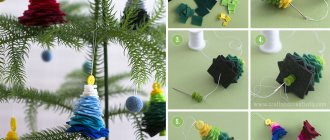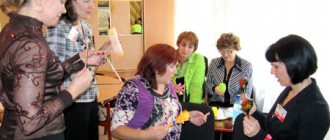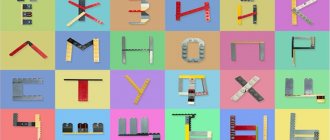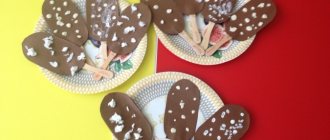Folder - travel "Autumn" : three folders - travel for kindergarten with pictures, poems and tasks for children about autumn.
In this article you will find three folders—movements on the theme “Autumn” for parents of children of different ages and useful ideas for using them:
- folder “Autumn” for early ages (from 2 to 3 years),
- folder “Autumn” for children of primary preschool age (for children 3-4 years old),
- “Autumn” folder for older preschool children (5-7 years old).
Each folder contains 10 sheets and you can choose those that will be most interesting to you and your children and arrange them in any order. Therefore, we did not specifically number the sheets.
All folders - translations on the theme “Autumn” from this article can be downloaded for free and printed. I have provided download links below in this article.
Folders - moving “Autumn” for preschoolers: contents of folders
Each of the three folders contains the following pages:
- What does a child of this age know about autumn? What to tell him about.
- Pictures about autumn to look at with your child.
- Educational autumn games and experiments.
- Poems about autumn to read to children and memorize.
Each page has a landscape sheet format - A4 (vertical).
The material in each folder is designed taking into account the age of the children and all methodological requirements for familiarizing preschoolers with the world around them.
All sheets of folders are colorful and bright, realistic and are designed so that the pictures can be viewed with a child while discussing autumn phenomena in nature.
We tried very hard to create a special mood in each folder and look at autumn through the eyes of a child! And also bring joyful mood and smiles to all of you - our readers! Therefore, the folders turned out to be very bright and kind, very sunny and bringing you our warmth!
The authors of the “Autumn” folders are: I, Asya Valasina, Candidate of Pedagogical Sciences in the field of preschool pedagogy, practical teacher, author of this site “Native Path”. And designer Anna Novoyarchikova.
All materials in the book folders can be transferred to friends, colleagues, acquaintances, downloaded and printed, and used in kindergartens, centers, and families. We, the creators of these folders, will be glad if our work is in demand and needed by people, and as many people as possible use it! Therefore, we make these folders free for distribution and you can get them without any payments or subscriptions.
Why do teachers need “Autumn” folders?
- Folders can be used as visual material for parents in kindergartens and children's centers (for example, a mobile folder can be located in the hallway of a kindergarten or in the locker room of a kindergarten group). This folder introduces parents to what educational games they can play with their child in the fall, what poems about autumn are intended for children of this age, and what to tell the child about in the fall.
- Folders can also be used as handouts for parents of preschool children on the topic “Autumn” at various family workshops and play libraries,
- The mobile folder can be printed as an A4 book, inserted into files (for this you need to purchase special folders with files) and get the book “Autumn” for the kindergarten group. This book can be passed from family to family and viewed in a group with children. It will serve you for a very long time!
Master class for teachers “Creating poster consultations for parents in the Canva application”
Master class for teachers
“ Creating poster consultations for parents in the
Canva ”
Korosteleva L.A., teacher at the Moscow Preschool Educational Institution
"Kindergarten No. 42, Verkhnyaya Pyshma"
Target:
expand teachers’ ideas about modern effective forms of interaction with parents.
Tasks:
— reveal the advantages of poster consultation over other forms of informing parents (theoretical aspect).
— reveal the basic requirements for poster consultations.
— train teachers in the skills of developing poster consultations.
Participants:
preschool teachers.
The relationship between kindergarten staff and parents at the present stage is one of the most difficult problems. There are different views of parents on cooperation between kindergarten and family. Many people believe that kindergarten should educate their children. There is a category of parents who neglect the advice of teachers. Some parents believe that their only task is to ensure that the child is fed, clothed, and that his only activities at home are watching cartoons and going for a walk.
The interaction of educators with families of pupils is one of the most important conditions for the formation of a child’s personality and positive results in upbringing, which can be achieved with coordination of actions and subject to the development of parents’ interest in issues of upbringing and education.
V.A. Sukhomlinsky emphasized that the tasks of education and development can be successfully solved only if the kindergarten maintains contact with the family and involves them in its work.
The content of work with parents is implemented through various forms. There are traditional and non-traditional forms of communication between teachers and parents of preschool children, the essence of which is to enrich them with pedagogical knowledge.
Traditional forms of working with parents are divided into:
- collective (parent meetings)
- individual (pedagogical conversations, consultations)
- visual and informational - they introduce parents to the conditions, tasks, content and methods of raising children, help overcome superficial judgments about the role of kindergarten, and provide practical assistance to the family (exhibitions of children's works, stands, screens, moving folders)
.
Currently, non-traditional forms of communication with parents are especially popular among both teachers and parents.
Today I would like to introduce you to an unconventional form of work - poster consultation.
What is a poster, how is the term “poster”
in various sources?
A poster is a kind of announcement, placard, poster.
In our case, poster consultation is understood as a form of informing parents through posters, the content of which is concisely and briefly presented information addressed to parents.
Recommendations for posters:
- information for parents - in the language of the parents, do not use abbreviations or professional terms.
- readability, clarity, clarity
-links with Qr codes.
Modern technologies can significantly speed up and facilitate the process of creating posters and placards. In this master class we will take a closer look at the Canva online editor. The Canva service does not require intensive training or a deep understanding of design, is accessible from any computer or phone with Internet access, and has an intuitive interface that even an inexperienced user can understand.
How to use the
Canva :
First of all, you need to register and log into your profile.
Ready-made templates
You will find a large number of templates for creating posters, covers and much more, thanks to which you can choose the theme for any of your projects.
I will look at examples of posters. Going to the appropriate section, I look at all the available options. By the way, they are constantly updated with new samples.
If you wish, you can swap all the elements within the layout, remove unnecessary details or add new icons from the collection - here everything is limited only by your imagination.
Images
Canva has its own photo and image storage, or you can use photos, pictures from your phone or computer.
User ideas
If you run out of inspiration, you can at any time get acquainted with the projects of other users who have posted their work on the site.
Smartphone app
You can use the Canva service using the mobile application. The mobile application does not have as much functionality as the browser version, but it is enough to correct or supplement projects.
Fonts
Canva has a large selection of fonts. Some are available for free, and some have a Pro version.
Create
Qr code
Add a URL, click on the create code button and add it to your design. By scanning the Qr code, people will be able to navigate to the target URL.
Reflexive analysis of the content of the activity in the form of syncwine:
1. One noun on the topic of the master class.
2. Two adjectives on the topic of the master class.
3. Three verbs on the topic of the master class.
4. A sentence characterizing the essence of the concept on the topic of the master class.
5. Synonym for the topic of the master class.
I always ask myself questions: what am I doing? for what purpose? what are the results? How did I achieve this? Can we do better? what will I do next?
As long as I ask myself these questions, I develop. As soon as I start to be satisfied with what I have achieved, my professional growth stops.
Good luck to you colleagues in everything. Thank you for your attention.
How parents of preschool children can use the “Autumn” folder
Option 1: Print the folder. And use it as a book or as a cheat sheet throughout the day.
Examples of using a move about autumn: We print the folder onto separate A4 sheets. Then it is very convenient to use these sheets with children, choosing the desired sheet for today. You can always take one piece of paper with a poem on a walk with your baby. And during a walk, take it out, look at the picture with your child, and read a poem to the child from this piece of paper. A sheet of paper from a folder looks very aesthetically pleasing and is convenient to look at with your baby; it is light and does not take up much space like a book or album. Then you and your child can look at the nature around you and find signs of autumn - the same as in the picture or in the poem from the folder.
A valuable idea from the experience of mothers: Many parents hang sheets of folders on the refrigerator (changing them) or on a home magnetic board and look at them with their children. These sheets serve as a cheat sheet - a reminder of a poem or a fall game planned for today with your child.
Option 2. Mobile option for using a folder about autumn without printing the folder on a printer. This option appeared in my experience of working with parents many years ago, when mobile phones with camera functions first appeared. Very convenient, fast way. You just need to save the pictures from the “Autumn” folder to your mobile phone. During a walk, you can always open the desired photo and read a poem to your child, look at the picture and find a similar landscape in the park around your baby, or remember an idea for a game and immediately play it with your child.
Working with a group of children, I often made such development folders and noted that parents did not just read them (and this is often what happens: they read them and happily... forgot). On the contrary, almost everyone takes pictures of my materials on their mobile phones and then returns to them at home and saves them for themselves. This is very convenient - you will always have a folder about autumn with you and does not take up space. Therefore, I decided to share “Native Path” with all readers.
We made three folders - movements about autumn according to the ages of children: early age (up to 3 years), junior preschool age (3-4 years), senior preschool age (5-7 years).
Now I will show examples of pages from folders - movements about autumn and give links to download these pictures in full format for printing.
Mobile folder » My city. I’m proud of you, my Kamchatka!”
A rectangular double-sided panel of white color with a width to length ratio of 2:3, reproducing along the lower edge a blue stripe 1/6 of the width of the flag, which depicts the figures of the coat of arms of the Petropavlovsk-Kamchatka urban district, made in black, gray and red.
In the silver field there are three black fire-breathing mountains (the middle one is in front of the other two) with scarlet flames and black smoke above them. The shield is crowned with a golden tower crown with five visible teeth, with a laurel branch along the lower edge and with two naked swords crossed behind the crown with silver blades and gold hilts. Shield holders - silver in golden robes, the Holy Apostles Peter (on the right) and Paul (on the left), supporting a shield with one hand, and in the other having: Peter - silver keys and a scroll, Paul - a book. The base is two golden sea anchors placed crosswise, paws down. The shield is surrounded, the base is entwined with the ribbon of the Order of the Red Banner of Labor.
Flag
Coat of arms of Petropavlovsk-Kamchatsky
Monument to Peter and Paul
The opening took place in 2005. Then it was consecrated by representatives of the Russian Orthodox Church. The monument was erected in honor of the apostles, after whom Bering named the city in his time. The bronze monument stands on a high pedestal. It depicts Peter and Paul near a large cross. The installation site was chosen to be the embankment of Avachinskaya Bay, where the expedition members landed. The sculptor Isakov was responsible for the project.
Nikolskaya Sopka
It is located close to the historical center of Petropavlovsk-Kamchatsky. During the Crimean War, fighting took place here. In honor of a number of historical events associated with Nikolskaya, several monuments were erected, as well as cannons in the place where Maksutov’s battery stood. It is picturesque both in winter and in summer, when it is almost completely overgrown with dense greenery. It is classified as a natural monument. Popularly called the “hill of love.”
Sights of Petropavlovsk-Kamchatsky
Avacha Bay
The city is located on its northern coast. Marked on maps in 1729. Occupies 215 km² from the Pacific Ocean. It does not freeze, which makes it convenient to use as a port. The depth allows you to accept any vessels without restrictions. For tourist walks or other movements, you need to obtain permission, since there are military bases nearby.
"Home Volcanoes"
They are also called the Avacha group of volcanoes. There are 6 of them in total: the main ones are Avachinsky, Kozelsky and Koryaksky, and Vilyuchinsky, Gorely, Mutnovsky are also sometimes added to them. Of the base three, only Kozelsky is considered completely extinct. The largest is Koryaksky, whose height
reaches 3456 meters. Avachinsky –
the most popular of the volcanoes. They climb it and organize an annual festival.
Poems about Petropavlovsk-Kamchatsky
Petropavlovsk-Kamchatsky Petropavlovsk lives By the volcano under the armpit, Well, the neighbor has a break for now. It would be nice to stretch out for a thousand years! The handsome neighbor is slowly smoking. The Great Ocean sighs nearby. He sends violent winds, And a quiet fog, He counts the tides, Like a pulse on a hand, And he forgets the jellyfish On the black sand.
(R. Aldonina)
A distant land of smoking volcanoes, Lakes of the purest, fish and caviar, Places that cannot be found in foreign countries, Places of pristine wild beauty,
The land of wild garlic and tart honeysuckle, Where brown bears and submarines are home, Where you will be treated to your heart's content with sockeye salmon, And flounder, and crab, and char...
The land of rocks and bays, cloudberries, princes, the land of fast rivers and stone birches, the land where under the fussy cries of seagulls, the old sea and the cliff are arguing...
A land where seals are quick to catch fish, Where boiling water flows from the ground to the sky, A distant land called Kamchatka - Like you,
God has not created many miracles...
My city.
“I’m proud of you, my Kamchatka!”
Detailed description of folders - movements about autumn by age of children
Please note: In this article I am giving compressed images from a folder as an example.
You can download full pictures from all folders in excellent quality in the file using the links above.
Each folder is unique and the contents of each folder are not duplicated in other folders.
Folder - moving "Autumn": for parents of young children (2-3 years old)
The moving folder about autumn for young children includes the following sheets:
- Title,
— What does a 2-3 year old baby know about autumn? And pictures of autumn natural phenomena to look at with your child.
— Learning to look at pictures: seasons
— Learning to speak and playing with the autumn rain: speech exercises on a home walk.
— Autumn educational games and tasks for the little ones: “Colorful leaves”, “Big - small”, “Dance with leaves”, “Where is the leaf?”, “What can you hear?”, “Learning to speak”, “Magic box”.
— We introduce the baby to the outside world during a walk in the yard
— Poems about autumn for the little ones: “Why do trees shed their leaves in autumn?” V. Orlov, “My little guest” V. Orlov, “Autumn Leaves” by I. Tokmakov, “Autumn Song” by A. Pleshcheev, “Autumn” by V. Avdienko, “Hedgehog” by I. Mogilevskaya, “Autumn” by Y. Korinets.
— Sheets “And this is me in the fall” for pasting home autumn photographs into an album or folder. You can paste autumn photographs of children, kindergarten groups, and photographs of children’s drawings about autumn into frames. The result will be sheets of galleries in which the baby will see himself! It is very important for a young child to look at photos of his mom, dad, all his relatives and himself in the fall: what the weather is like, who is doing what, who is wearing what.
The download link for this folder is given above in this article.
Folder - moving "Autumn": for parents of children 3-4 years old
Below in the folder description are examples of pictures in a compressed format. You can download the same pictures in full size and good resolution for free above in this article in the section “Download moving folders “Autumn”
The moving folder about autumn for children of primary preschool age includes the following sheets:
- Title,
— What does a 3-4 year old child know about autumn?
— Poems about autumn for children 3-4 years old: I. Bunin “Autumn”, K. Balmont “Autumn”, A. Koltsov “The winds are blowing”, M. Khodyakova “If the leaves on the trees turned yellow”, E. Trutneva “It suddenly became twice as bright”, A. Teslenko “Autumn”, A. Pleshcheev “Boring picture”, L. Razvodova “The rain of mischievous leaves swirled above me.”
— Educational games on an autumn walk with a 3-4 year old child: “Which branch are the children from?”, “Casts from nature”, “Drawing a herbarium from leaf prints”, “Find the same one”, “Developing the eye. Swing for a leaf", "Introducing a child to trees", "Leaf prints with colored pencils", "Riddle game: autumn trees"
— Autumn mathematics on a walk with a child: “How are they similar?”, “What is more?”, “Continue the pattern.”
— For little reasons: why is the hare white in winter and gray in summer? Experiment for children.
— Signs of autumn: pictures with the task for the child “Find the signs of autumn.” While discussing the top picture with your child, ask him why this is not summer? After all, it also rains in summer. Pay attention to the girl's warm clothes. If she dressed warmly, that means...? (it’s cold outside, but warm in summer). In the bottom picture, find signs of autumn (the harvest is ripe, the leaves are falling).
My kindergarten
Author: teacher of the highest category Margarita Vladimirovna Glagoleva, MDOU N20, Efremov, Tula region.
Folder - mobile for decorating the parent's corner, dedicated to the holiday "Victory Day"
On May 9, the most terrible war of the 20th century, the Great Patriotic War, ended. The path to victory was difficult. Our people lost 20 million of their sons and daughters in this war. These are warriors who died on the battlefield. These are civilians and prisoners of war, killed and tortured by the Nazis in occupied territory.
Folder – mobile for decorating a parent’s corner, dedicated to the holiday “Teacher’s Day”
The first kindergarten in Russia was opened in St. Petersburg on September 27, 1863. Together with her husband, Adelaida Semenovna Simonovich, a great enthusiast and visionary, founded it. Her establishment accepted children 3-8 years old. The “garden” program included outdoor games, construction, and even a Homeland Studies course. But this was not enough for Simonovich, and she began publishing a special magazine “Kindergarten”. This is where the date of the celebration came from - September 27 - - it was on this day in 1863 that the first kindergarten in Russia was opened in St. Petersburg on Vasilyevsky Island.
Folder - a mobile device for decorating a parent's corner, dedicated to an autumn theme.
The world around a child is diverse and diverse. For a child, this is family, kindergarten, and hometown. This is the world of adults with whom he communicates, the world of objects that surround him in everyday life. In kindergarten, during classes and during walks, we try to make this knowledge about the world around us more accessible and understandable for the child.
Folder - mobile for decorating the parent's corner, dedicated to the Easter holiday
The word "Easter" means the transition from death to life, from Earth to Heaven. Previously, this was the name of the holiday in memory of the deliverance of the Jews from Egyptian slavery. In the New Testament Church, this is a sign that the Son of God Himself, through the resurrection from the dead, passed from this world to the Heavenly Father, from Earth to Heaven.
Folder – mobile for decorating the parent’s corner, dedicated to the holiday “Broad Maslenitsa”
Maslenitsa is a favorite folk holiday. It happens on different days every year. They occur from the second half of February to the first days of March. This is because the beginning of Maslenitsa depends on Easter. And the time of Easter also changes from year to year. Maslenitsa is a cheese and meat week. This is because they don't eat meat. But there is plenty of cheese, sour cream, butter and, of course, pancakes.
Folder - a slider for decorating a parent's corner in a nursery group.
While walking with your baby, explain to him that winter is over and spring has come. Draw your child’s attention to the fact that the snow has melted, streams are running, and the sun is shining brightly. Together with your baby, look at the green grass and blooming flowers, draw your child’s attention to how beautiful it becomes in the kindergarten area, near the house with the appearance of grass and the first spring flowers, teach him to rejoice at their appearance.
The mobile folder is dedicated to the Victory Day holiday.
The first fireworks in Moscow were given in honor of the successful offensive of the Red Army in the Oryol and Belgorod directions on August 5, 1943. It must be said that at that time in the USSR there were no special fireworks units, no fireworks ammunition with equipment. The fireworks were carried out “with improvised means” by artillery crews of the air defense forces and the garrison of the Moscow Kremlin. After this, a tradition was established of organizing fireworks in honor of the successes of the Soviet army in battles with the Nazis.




